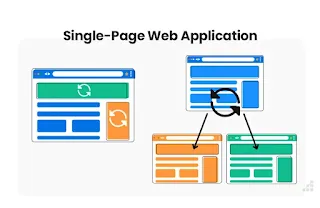In the vast landscape of the internet, web applications play a pivotal role in shaping our online experiences. Defined as software applications accessed through web browsers, these applications have evolved significantly over the years, becoming indispensable in our daily digital interactions. Except wasting time let’s start exploring their evolution, types, key components, security measures, and much more. Did you know there are also to ten website designs, super hot for your business. Read by clicking here.
Evolution of Web Applications
In the early days of the internet, web applications were rudimentary and mostly static. However, with technological advancements, we witnessed a shift towards dynamic and interactive applications. This evolution paved the way for the sophisticated web applications we use today. To know more about new features which are perfect for your business, follow us on Facebook, Instagram and LinkedIn.
Key Components of Web Applications
At the heart of every web application lie three fundamental components: front-end development, back-end development, and databases. The synergy between these elements determines the functionality, user interface, and overall performance of the application.
Popular Web Development Frameworks
Web Application Security
Security is a paramount concern in the realm of web applications. From common threats like SQL injection to best practices in secure development, maintaining a robust security posture is crucial for protecting user data and ensuring the integrity of applications.
Importance of Responsive Design
As mobile usage continues to soar, the importance of responsive design cannot be overstated. Web applications must adapt seamlessly to different devices, ensuring a consistent and user-friendly experience across desktops, tablets, and smartphones.
Challenges in Web Application Development
Building web applications comes with its set of challenges, including cross-browser compatibility, scalability issues, and the continuous need for updates and maintenance. Navigating these challenges requires a strategic approach and a commitment to delivering high-quality products.
Web Applications vs. Mobile Applications
While web applications and mobile applications share similarities, they differ in key aspects. Understanding these differences is crucial when deciding on the platform that best suits the goals of a particular project.
Future Trends in Web Application Development
The future of web application development is exciting, with trends like artificial intelligence integration, augmented reality applications, and blockchain shaping the landscape. Staying up-to-date of these trends is essential for both developers and businesses looking to stay competitive.
Case Studies: Successful Web Applications
Examining successful web applications provides valuable insights into effective development strategies. From innovative features to lessons learned, case studies offer a wealth of information for aspiring developers.
Tips for Building Effective Web Applications
Crafting effective web applications requires attention to detail and a user-centered design approach. Performance optimization, accessibility considerations, and a focus on the user experience are key factors in creating applications that stand out.
User Experience and User Interface Design
The user experience (UX) and user interface (UI) design are integral aspects of web development. Ensuring a seamless and visually appealing interface enhances user satisfaction and contributes to the overall success of an application.
Testing and Quality Assurance in Web Development
Thorough testing is a non-negotiable step in web development. From unit testing to user acceptance testing, implementing rigorous testing methodologies is essential for identifying and addressing potential issues before deployment.
Types of Web Applications
Web applications come in various forms, each serving a unique purpose. From static websites with fixed content to dynamic and responsive single-page applications (SPAs), and the emerging trend of progressive web applications (PWAs), developers have a excess of options to choose from when crafting digital experiences.
Static Web Application
Static web applications, often underestimated in their simplicity, have witnessed a resurgence in modern development. Defined by fixed content that doesn’t change unless manually updated, static sites excel in scenarios where constant updates are unnecessary. Delving into the core characteristics of simplicity and speed, we explore case studies of successful static websites that have not only stood the test of time but have also significantly contributed to user satisfaction. The emergence of static site generators in modern development practices adds a layer of efficiency and scalability to the static web landscape.
Dynamic Web Applications
Dynamic web applications inject a real-time element into the user experience, offering personalized content and interactions. As we embark on a comprehensive exploration of dynamic content and its advantages, we also navigate the challenges and considerations inherent in developing dynamic web applications. Real-world examples showcase the power of dynamic features in enhancing user engagement, while the integration of serverless architecture emerges as a game-changer in addressing scalability concerns.
eCommerce Web Application
The transformation of traditional businesses into online powerhouses is epitomized by eCommerce web applications. Beyond facilitating seamless online transactions, these applications boast features such as secure payment gateways, inventory management, and robust user authentication. Our detailed exploration extends to case studies of successful eCommerce web applications, shedding light on the critical role of security and the infusion of artificial intelligence in enhancing the personalization of eCommerce experiences.
CMS Web Application
Content Management Systems (CMS) have not only revolutionized content creation and management but have also democratized these processes. In an in-depth analysis of CMS functionality, we conduct a comparative examination of popular platforms such as WordPress, Drupal, and Joomla. The evolution of CMS extends beyond content management, influencing collaboration and content delivery. We also delve into the rise of headless CMS, providing more flexibility in content delivery and the creation of omnichannel experiences.
Single-Page Web Application
Single-Page Web Applications (SPAs) have risen in prominence due to their seamless user experiences, facilitated by loading content dynamically on a single page. Advantages in user experience, performance, and smooth transitions between sections make SPAs a preferred choice for certain applications. Case studies delve into successful SPA implementations, shedding light on the impact of modern JavaScript frameworks in shaping the SPA landscape.
Multi-page Web Application
In the realm of multi-page web applications, the traditional approach of navigating through different pages persists. We undertake an in-depth examination of considerations when choosing multi-page applications, balancing search engine optimization (SEO) advantages with development complexity. The role of microservices emerges as a key factor in enabling modular and scalable multi-page applications, offering insights into the evolving landscape of web development.
Portal Web Application
Portal web applications serve as centralized gateways to information and services, aggregating content and functionalities into a unified platform. In exploring their definition and significance, we delve into case studies illustrating the role of portal apps in streamlining information access, particularly in corporate environments. The integration of AI-driven chatbots adds an interactive layer to portal applications, enhancing user engagement and providing personalized assistance.
Animated Web Application
The integration of animations in web applications serves as a powerful tool in enhancing user engagement and storytelling. From subtle transitions to eye-catching visuals, animations contribute to a more immersive interaction. However, achieving the right balance is crucial, as detailed case studies reveal the potential impact of excessive animations on loading times and overall performance. We also explore advanced technologies like WebGL and animation libraries, pushing the boundaries of web animation.
Progressive Web Apps
Progressive Web Apps (PWAs) represent a fusion of web and mobile applications, offering offline functionality, push notifications, and a responsive design without the need for installation. Case studies on successful PWAs across different industries illustrate how these features significantly enhance user retention and satisfaction. The role of service workers in enabling offline functionality and enhancing PWA performance is explored, along with progressive enhancement strategies for existing web applications transitioning to PWAs.
Rich Internet Applications
Rich Internet Applications (RIAs) offer advanced user interfaces and functionalities, often leveraging technologies like Adobe Flash or HTML5. The transition from Flash-based RIAs to modern technologies has reshaped the landscape, with HTML5 leading the way in providing rich, interactive experiences within web browsers. Real-world case studies highlight the capabilities of RIAs and their influence on user interaction, emphasizing the convergence of RIA features with modern browser capabilities.
Conclusion
In conclusion, the world of web applications is diverse, catering to various needs and preferences. Choosing the right type depends on factors like the nature of content, user engagement goals, and technical requirements. It’s crucial to weigh the pros and cons carefully to make informed decisions that align with your objectives.









.webp)







































